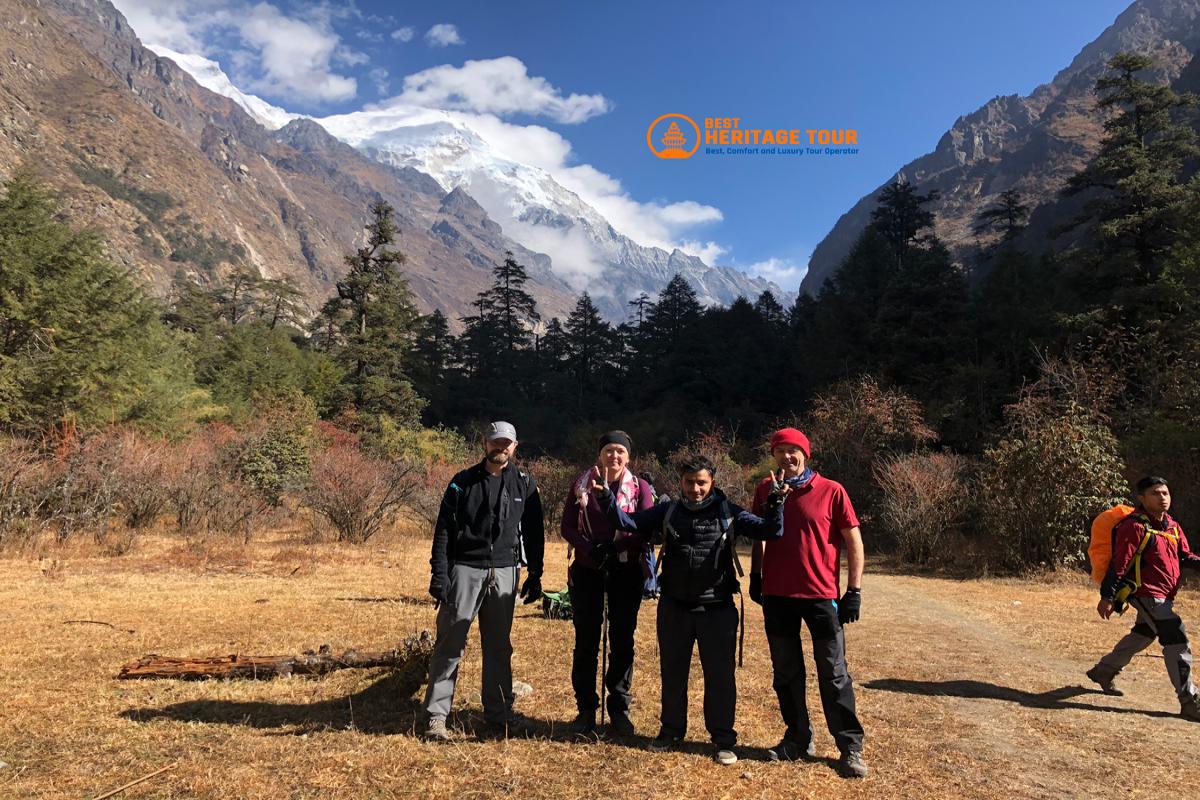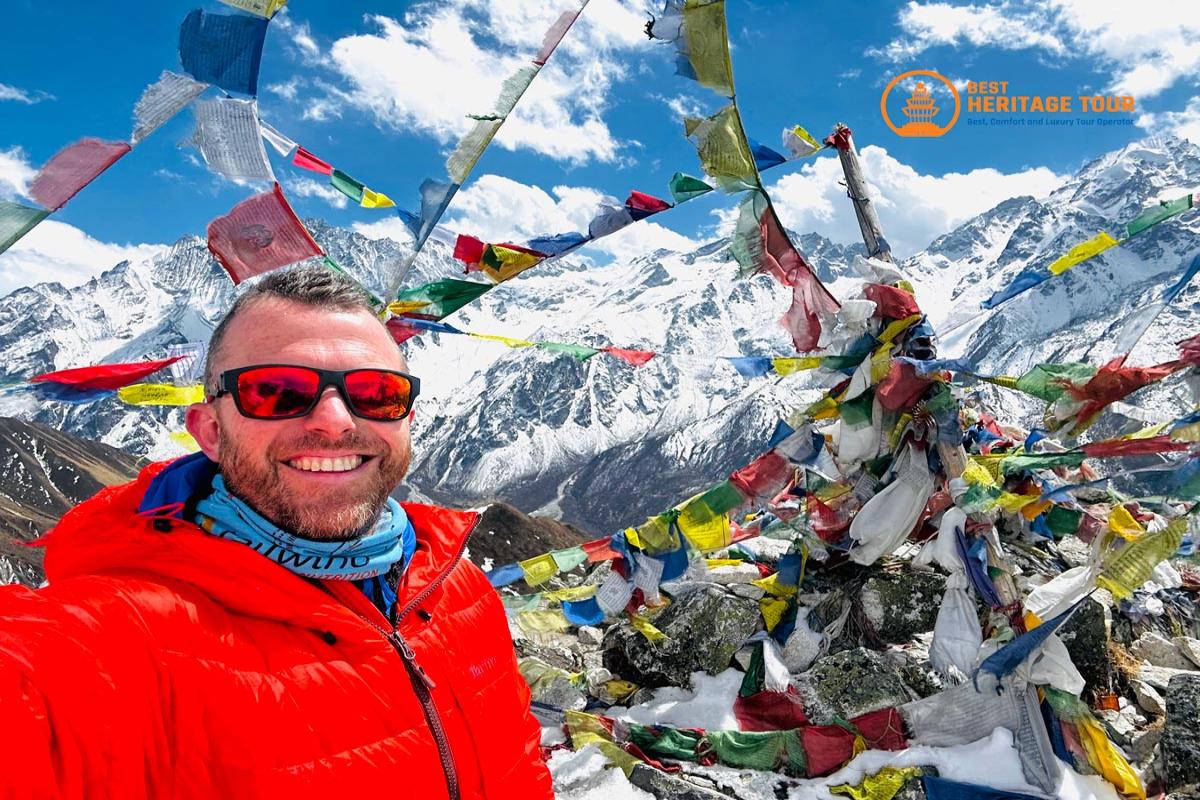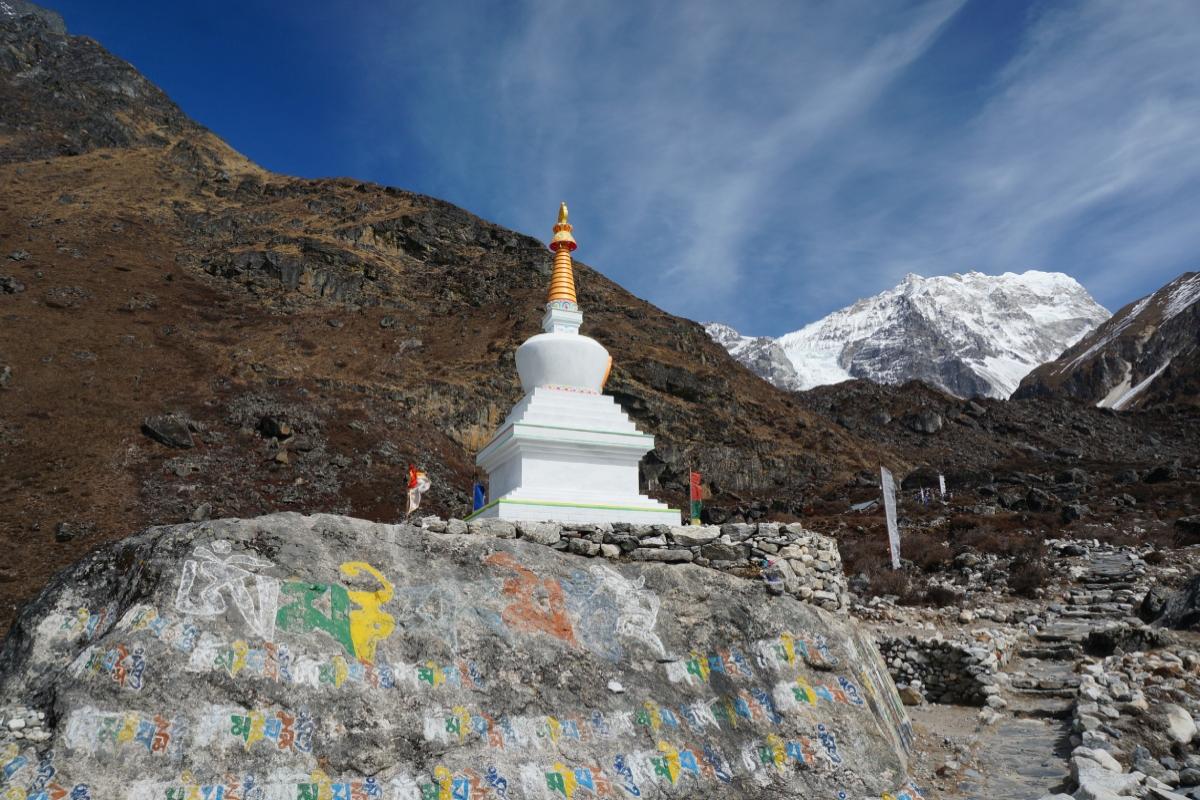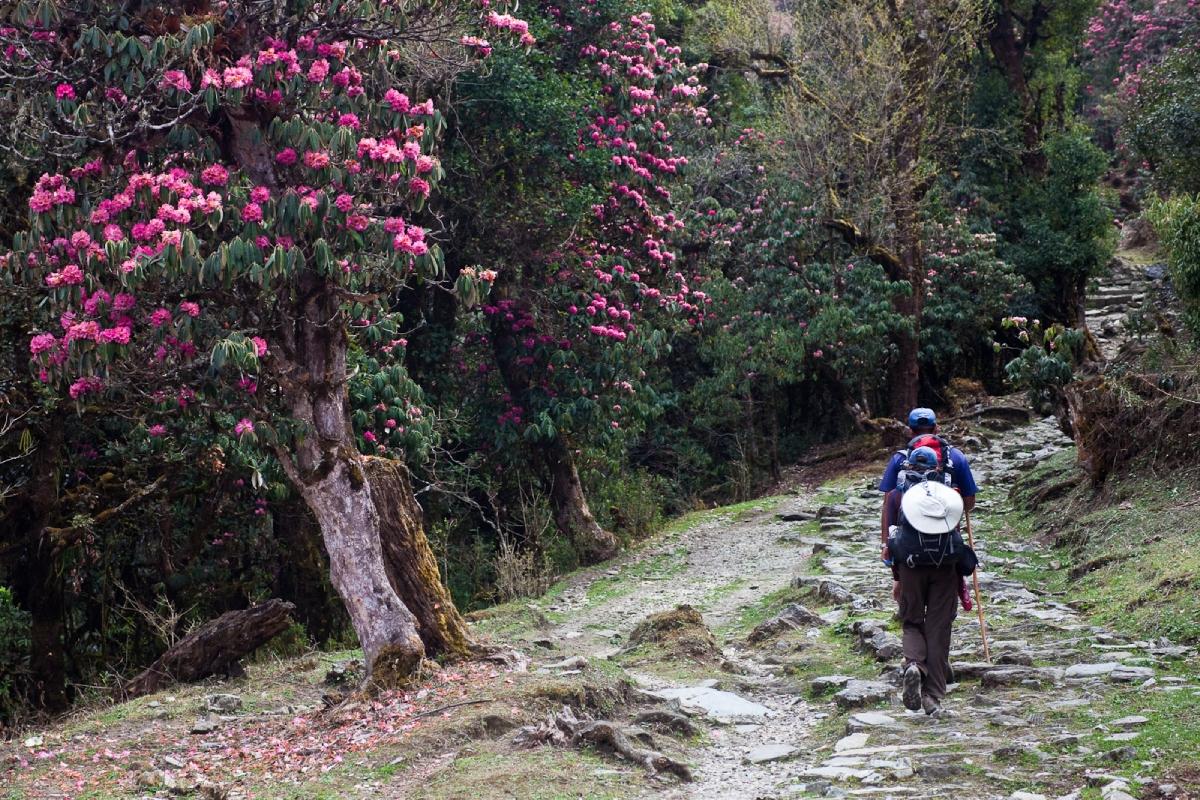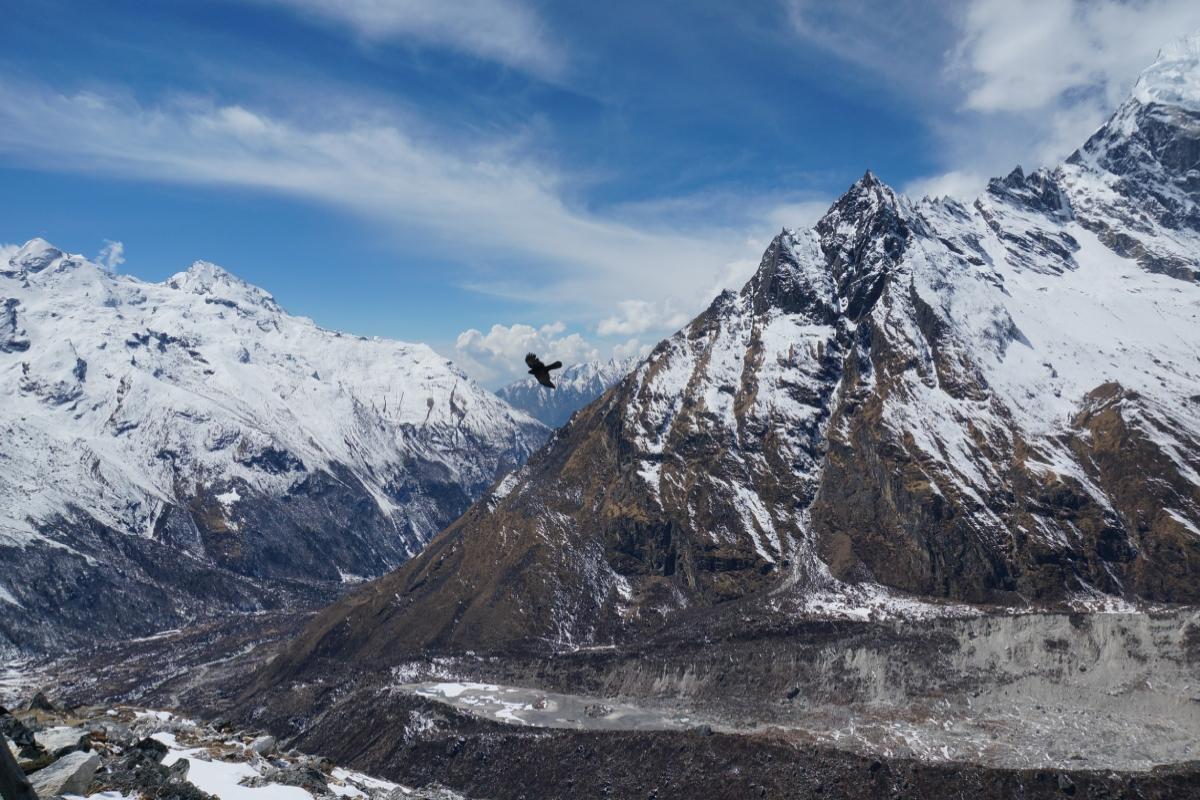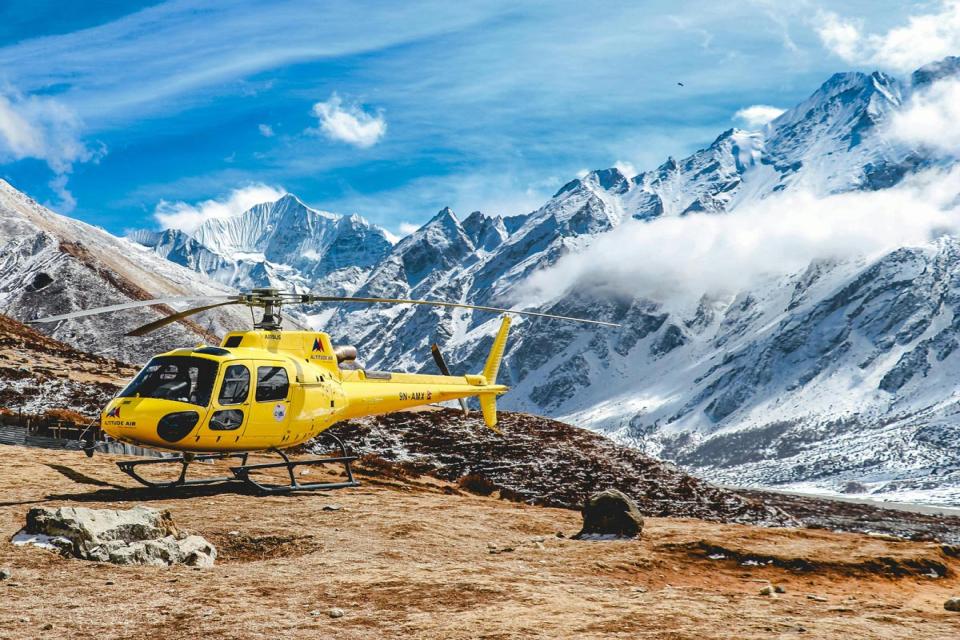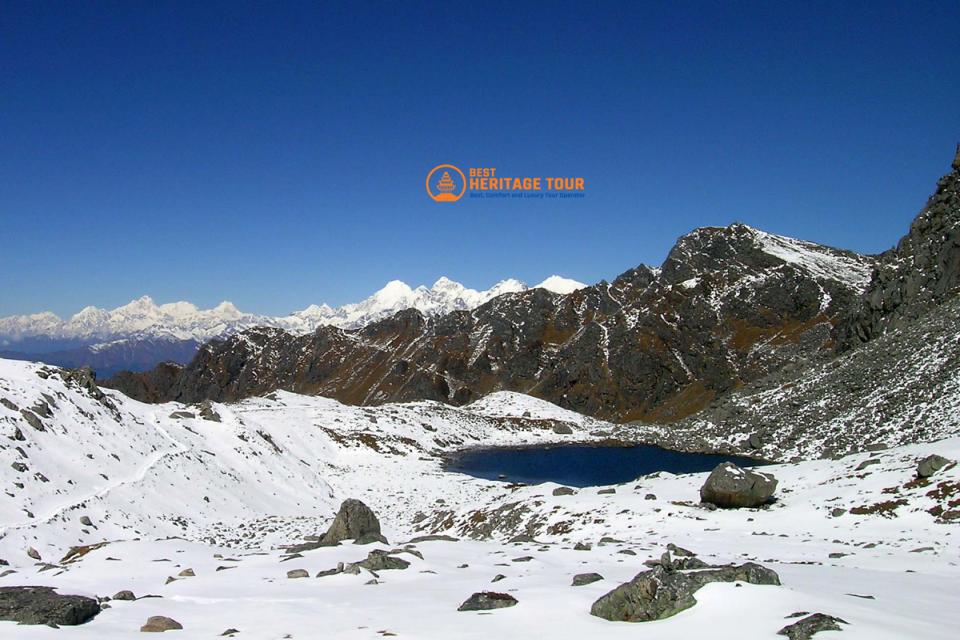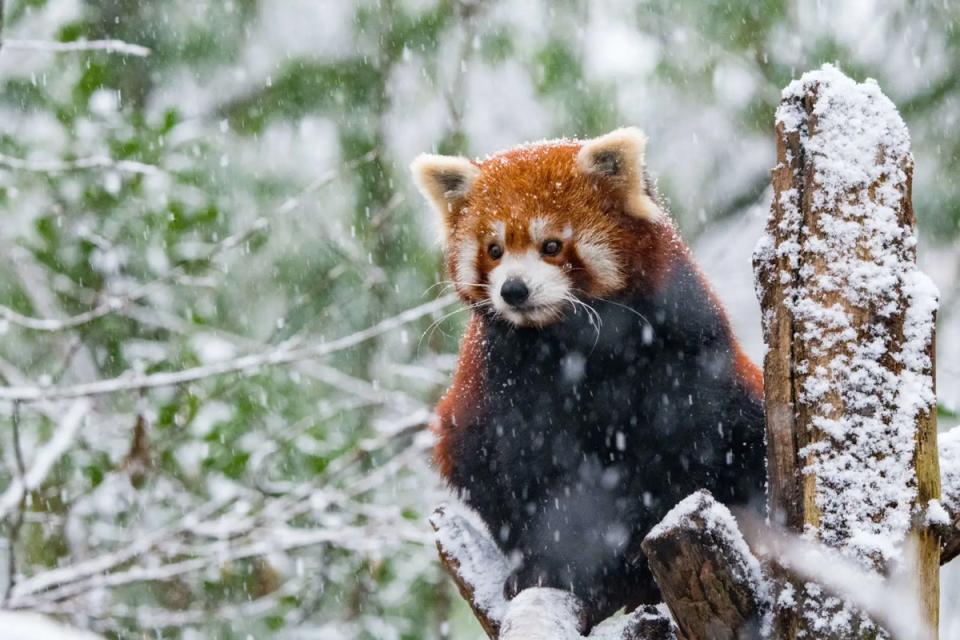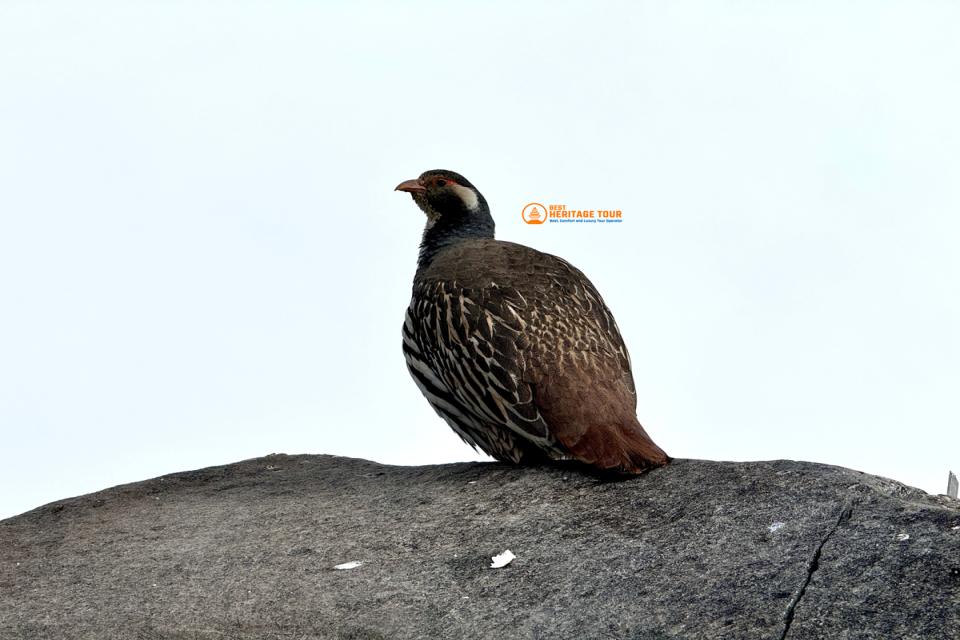Langtang Valley to Kyanjin Gompa Trek - 8 Days
Insight on Langtang Valley Trek
The Langtang Valley Trek is a beautiful journey into one of Nepal’s most accessible yet breathtaking trekking regions. Just a short drive from Kathmandu, this trek offers a perfect mix of Himalayan scenery, cultural encounters, and natural beauty. You’ll pass through dense forests, traditional Tamang villages, and alpine meadows, all framed by stunning views of Langtang Lirung and surrounding peaks. The highlight is Kyanjin Gompa, a serene mountain village where you can explore monasteries, glaciers, and viewpoints. Ideal for trekkers seeking a shorter adventure, the Langtang Valley Trek combines cultural richness with high-altitude landscapes in less than two weeks.
Trip at a Glance
Key highlights
- Scenic drive from Kathmandu to Syabrubesi, the gateway to the Langtang region.
- Trek through lush forests of rhododendron, oak, and bamboo with chances to spot wildlife like red pandas and langur monkeys.
- Explore traditional Tamang villages and experience their Tibetan-influenced culture and warm hospitality.
- Stunning views of Langtang Lirung, Dorje Lakpa, and other majestic Himalayan peaks throughout the trek.
- Visit Kyanjin Gompa, a beautiful mountain village surrounded by dramatic landscapes.
- Optional hikes to Kyanjin Ri or Tserko Ri for panoramic high-altitude viewpoints.
- Opportunity to visit a local cheese factory in Kyanjin for a unique cultural experience.
- A short yet rewarding trek that combines natural beauty, culture, and adventure in just over a week.
Benefits of booking Langtang hike with Best Heritage Tour
- Free transfer from Tribhuvan International Airport (TIA) to your hotel or vice versa
- Online trip discussion after booking confirmation
- Pulse oximeter to monitor blood oxygen saturation at high altitude.
- Medical kit
- Easy booking and reservation system
- Multi-channel communication (email, WhatsApp, Facebook, WeChat, Viber, Skype, Zoom)
- 24/7 phone contact at: +977-9851149197 / +977-9810043046 for any assistance
- Simple payment system.
- Sleeping bag and trekking poles provided if you don't have your own
- Free luggage storage at BHT store during the hike
Online trip discussion
In our online meeting, we will clear all your doubts about the hike, including what you need to bring for the hike (Equipment checklist), itinerary details, precautions on the trail, etc. After completing your booking, we will inform you by email of the date and time available for the trekking meeting, and we will hold the online trekking meeting once we receive the necessary documents.
Comprehensive Trekking Overview
This trekking area in Nepal is highly sought after by many adventurers. Langtang National Park is home to beautiful landscapes, meadows and ancient monasteries.
On this hike, you will be pleasantly surprised as you pass through forests and enjoy breathtaking views of mountains, valleys and glaciers. Chortens, mani walls and monasteries reflect the Buddhist influence in this peaceful region. There are also options for side trips, such as hiking to Tserkoli and Kyanjin villages.
The trek starts with a drive along the Trishuli River north of Kathmandu, passing through Trishuli Bazar and Dhunche to the Sherpa village of Shabul Bensi. This route is an ancient trade route between Nepal and Tibet. While hiking through numerous forests, you can spot native wildlife such as musk deer, Himalayan geese, thales, wild dogs, seraws and even snow leopards.
It takes 2 days to reach Langtang. On the first day of the route, you will hike from Syabrubesi to Lama Hotel. The next day, you will reach Langtang village from Lama Hotel where you will be warmly welcomed by the local Tamang people.
The next day, you will hike to Kyanjin Gompa where you will spend another day acclimatizing. While acclimatizing, we explore the local monastery, visit a cheese factory and hike up to Tserkoli viewpoint (5,450m). From this viewpoint, we have a magnificent view of glaciers and high peaks such as Langtang Lirung (7,227m), Langtang II (6,586m), Yala Peak (5,520m) and Naya Kang (5,844m).
Another important viewpoint is Kyanjin Ri at 4,773m above sea level, which offers a magnificent view of the entire Langtang Lirung mountainside and the Langtang Lirung glacier below the summit.
For many, the trekking experience will be a once in a lifetime experience. Return from Kyanjin Gompa to Lama Hotel and hike south back to Syabrubesi. The next day, you will return to Kathmandu by bus. The journey takes approximately 7-9 hours. You will be returned to your respective Kathmandu hotel for a short and comfortable trekking experience.
A fun hike that is a bucket list item. This hike offers you the opportunity to explore the Langtang region, visit famous scenic spots, and experience the local lifestyle.
What You Can Expect from the Langtang Valley Trek?
1. Dramatic Himalayan Scenery
Throughout the trek, you’ll be surrounded by towering snow-capped peaks. Langtang Lirung, Dorje Lakpa, and countless other Himalayan giants create a breathtaking backdrop. From the alpine meadows to the rugged ridgelines, every step reveals a new perspective of the mountains. The optional hikes to Kyanjin Ri or Tserko Ri add even more unforgettable panoramic views.
2. Rich Cultural Encounters
The Langtang Valley is home to the Tamang people, whose culture and traditions are deeply influenced by Tibetan heritage. Walking through traditional villages, you’ll notice their unique architecture, colorful prayer flags, and Buddhist monasteries. Friendly locals often share stories, making this trek as much about culture as it is about nature.
3. Diverse Landscapes and Wildlife
The trail takes you from lush rhododendron and bamboo forests to high-altitude yak pastures and glacial valleys. Along the way, you may encounter wildlife such as Himalayan black bears, red pandas, or different species of birds. This variety makes the trek both scenic and adventurous.
4. Exploration at Kyanjin Gompa
Kyanjin Gompa is the highlight of the trek, a peaceful mountain village surrounded by dramatic peaks. Here, you can visit centuries-old monasteries, taste local yak cheese at the famous cheese factory, or hike to nearby viewpoints. It’s the perfect place to rest, acclimatize, and absorb the beauty of the Langtang Valley.
5. A Short but Rewarding Trek
Unlike longer treks in Nepal, the Langtang Valley Trek can be completed in just over a week without compromising on Himalayan experiences. It’s suitable for trekkers who want to explore high-altitude landscapes, enjoy cultural immersion, and still have time for other adventures in Nepal.
Are You Ready for the Langtang Valley Trek?
The Langtang Valley Trek is considered moderate in difficulty, making it accessible to many adventure enthusiasts. You don’t need to be extremely fit or experienced, but good health and a basic level of stamina will make the journey more enjoyable. Each day involves 5-7 hours of walking on varied terrain, including forests, stone steps, and gradual ascents. With steady pacing, proper acclimatization, and short breaks, most trekkers find the route manageable and rewarding.
This trek is perfect for those looking to experience the beauty of the Himalayas without committing to a long itinerary. If you are comfortable with multi-day hikes, love being surrounded by nature, and are excited to immerse yourself in local culture, you are ready for the Langtang Valley Trek. Preparation with the right gear, a positive mindset, and a willingness to embrace adventure will ensure an unforgettable journey.
Itinerary
After an early morning breakfast, your journey to Syabrubesi begins. You will leave Kathmandu and head north. On your journey, you will enjoy the magnificent views of rivers, terraced fields, small villages and snow-capped mountains.
Following this road, you will reach the small town of Dhunche. The trail along the Trishuli River offers glimpses of Ganesh Himal (7,422 m). From Dhunche you continue on until you reach Syabrubesi. You can wander around the town for a while, but don't forget to experience the riverside hot springs.
You start your trek from Syabrubesi, following the Bhote Koshi and Langtang Rivers, passing through fertile jungles, terraced fields, rural settlements rich in bamboo and birch groves. From the boardwalk you can observe rare wildlife, including red pandas. After a while, you will climb gently up to Limche (2,400 m) through dense bamboo forests along the banks of the Langtang River Continue the route until you reach Lama Hotel, your destination for the day.
You start the day with an early breakfast and hike along the river through lush landscapes and up through dense forests. On the way, if the weather is good, you will see snow-capped mountains right in front of you. Finally, at Goda Tabera (3,030 m), the narrow river valley widens. In the past, there was a Tibetan resettlement project here, but now there is a military checkpoint at Goda Tabera, where they register their documents. Besides the military checkpoint, there are several accommodation options here.
Continuing our hike, you reach the small settlement of Chamki village (3,230 m), passing chortens, waterwheels, mani walls and prayer wheels that indicate you are approaching Langtang village. You pass prayer wheels powered by running water and prayer flags, and head towards picturesque Langtang, a large settlement inhabited mainly by the Tamang people.
Pass through many small plateaus, large Mani forts, yak pastures, small villages and pastures. Walk slowly to allow your body to acclimatize as you gain altitude. After a while, you will see a waterwheel, a prayer wheel and a sacred rock cairn with inscriptions. This indicates that you have reached the ancient monastery Kyanjin Gompa (3,830m). Kyanjin Gompa is surrounded by the Himalayan ranges and from here you can enjoy amazing views of several snow-capped mountains.
Today is a rest day to acclimatize and explore this beautiful Langtang region. The Langtang Valley has a lot to offer hikers. The elevated terrains offer breathtaking views of the Himalayan peaks and ice formations.Visit Kyanjin Gompa and watch the monks pray. Another interesting spot is the cheese factory. You can also trek to the highest point of this trek, Langsisa Halka and Tserkoli lookout point (5,450m). Tserkoli is the best place to view peaks such as Langtang Lirung (7,227m) and Langtang II (6,586m). Another viewpoint, Kyanjin Ri (4,773m), offers magnificent views of the Langtang mountain range. As the sun sets, return to Kyanjin Gompa for the evening.
You leave Kyanjin Gompa behind and take your last views of the beautiful mountains that stand tall with pride and glory. But it is time to retrace your previous route to Langtang village and stop at Goda Tavera for lunch. You also register your departure at the military checkpoint at Goda Tabela.
After a leisurely lunch, you continue your journey through the elevated terrains offer breathtaking views of the Himalayan peaks and ice formations.
Today is the last day of hiking, so drive to Syabrubesi and return to Kathmandu. You hike along the Langtang River and descend into the beautiful river valley. You strategically navigate through picturesque landscapes as you make your way down through bamboo and birch forests, successfully crossing the Langtang and Bhote Kosi rivers to reach Syabrubesi. This concludes our trekking expedition. The following day, you return to Kathmandu by road.
The drive from Syabrubensi to Kathmandu takes approximately 7-9 hours. This trip starts early in the morning. On this drive you will enjoy beautiful views of the Trishuli River valley as you head south from the hills. Along the way you will see terraced fields, pastures and hopefully a final glimpse of snow-capped mountains. Upon arrival in Kathmandu, you will be accompanied to your accommodation.
What is included?
- Round trip transportation between Kathmandu and Syabrubesi by local bus
- Accommodation (7 nights total) - 5 nights accommodation with private bathroom in Syabrubesi, Langtang village & Kyajin Gompa, 2 nights standard accommodation in Lama Hotel (2N) (twin room)
- All standard meals during the trek (8 lunches, 7 dinners, 8 breakfasts).
- Nationally licensed and experienced trekking guides and porters to help trekkers with their luggage (1 porter for every 2 trekkers, with maximum luggage limit of 25 kg)
- Guide and porter fees, insurance, salary, accommodation, transportation and other necessary equipment
- All necessary permits fee: Langtang National Park entry permit & TIMS card
- Organization of rescue operations in case of health emergency (funded by travel insurance)
- Souvenirs - Best Heritage Tour Company T-shirt and Purse
- Farewell dinner in Kathmandu at the end of the hike
What is not included?
- Cost of international flight tickets
- Nepal entry visa fee at Tribhuvan International Airport
- All accommodation and meals in Kathmandu before and after the trip
- Extra overnight stay in Kathmandu due to early arrival, late departure or early return from the trek.
- Personal expenses - shopping, snacks, bottled boiled water, hot (tea/coffee) and cold drinks, hot showers, alcohol, Wi-Fi, telephone, battery charging fees, additional porters, etc.
- Personal clothing and equipment
- Travel insurance covering emergency rescue and evacuation at height (mandatory)
- Tips for guides and porters (customary)
- Additional expenses or delays due to circumstances beyond our control like Landslides, weather conditions, changes in itinerary due to safety concerns, illness, changes in government policies, strikes etc.
- Any costs not specified in the Itinerary and Included section
- All government taxes 13%, SSF, and 10% service charges
Route Map
Equipment
Head
-
Sun hat or scarf
-
Winter hat or insulated hat or wide-brimmed hat
-
Headlamp with spare batteries
Face
-
Sunscreen
-
Sunglasses with UV protection
-
Face/body wipes
Hands
-
Lightweight gloves
-
Thick winter gloves
-
Lightweight gloves
-
Thick winter gloves
Body
-
Hiking shirt
-
Long-sleeved shirt
-
Rain jacket with hood
-
Fleece jacket
-
Light cotton pants
-
T-shirt (bring your own light wool)
-
Polypropylene underwear
-
Down jacket (rent in Kathmandu)
-
Sweater
-
Waterproof jacket and pants
Footwear
-
Hiking shoes
-
Thick wool socks (bring an extra pair of thick, light socks)
Basic equipment
-
Backpack or daypack (size depends on whether you use a luggage rack or not). Thermos flask
-
Water filter
-
Walking stick
-
Sleeping bag (-15 is best for high altitude hiking)
Bathroom amenities
-
Medium sized dry towel
-
Toothbrush
-
Toothpaste
-
Deodorant floss
-
Biodegradable soap
-
Nail clippers
-
Small mirror
-
Personal accessories
-
Money
-
Clock
-
Cell phone
-
Camera
Extra items
-
First aid kit
-
Extra passport photo and passport copy
-
Notebook and pen
-
Binoculars
Trip Info
Best Time for the Langtang Valley Trek
The Langtang Valley Trek can be done at different times of the year, but the best experiences come during spring (March to May) and autumn (September to November). These seasons offer stable weather, clear skies, and the best mountain views. The trek is also possible in winter (December to February), though it comes with colder conditions, while the monsoon (June to August) is generally not recommended.
- Spring (March to May)
Spring is one of the most popular times to trek in Langtang. The weather is mild, skies are clear, and the hillsides come alive with blooming rhododendrons and wildflowers. Views of the snow-capped peaks are at their finest, and the trails are vibrant with both nature and fellow trekkers.
- Autumn (September to November)
Autumn is the peak trekking season thanks to its excellent weather conditions. Days are warm, nights are cool, and visibility is outstanding, making it the ideal time for mountain photography. The trails are dry and comfortable, ensuring easier walking and fewer weather-related challenges.
- Winter (December to February)
Winter trekking is possible in Langtang, but it is colder, especially at higher elevations like Kyanjin Gompa. The mornings may bring frost or even light snow, yet the skies remain crisp and clear, offering stunning views. With proper clothing and preparation, trekkers can enjoy quieter trails and a peaceful atmosphere.
- Monsoon (June to August)
Monsoon season brings heavy rainfall, slippery trails, and frequent landslides, making trekking more difficult and less safe. Mountain views are often obscured by clouds, though the valley becomes lush and green. While adventurous trekkers may still attempt it, this season is generally not recommended for the Langtang trek.
Permits Required for the Langtang Valley Trek
To trek in the Langtang region, you will need the following permits:
-
Langtang National Park Entry Permit
-
Trekkers’ Information Management System (TIMS) Card
All permits are included in the package and will be arranged by Best Heritage Tour, so you don’t need to worry about them. Make sure to carry a valid passport and a few passport-sized photos, as these are required for processing the permits.
A Typical Day on the Langtang Valley Trek
Most days on the Langtang Valley Trek start early in the morning with a light breakfast before heading out on the trail. You will hike through lush forests, terraced fields, rivers, and traditional Tamang villages, enjoying the fresh mountain air and stunning landscapes along the way. Midday breaks at teahouses allow you to rest, refresh, and enjoy a simple lunch before continuing to the next destination.
Evenings are spent settling into the teahouse, relaxing, and enjoying warm meals with fellow trekkers. Days like the Kyanjin Gompa exploration start early for optional hikes to nearby viewpoints or glaciers, providing panoramic views of Langtang Lirung and surrounding peaks. Each day combines adventure, nature, and cultural experiences, making the trek both manageable and unforgettable.
Accommodation and Meals
During the Langtang Valley Trek, accommodation is provided in comfortable teahouses and lodges along the trail. Rooms are generally simple, with twin beds, warm blankets, and shared bathrooms in most places. In some villages, private rooms with attached bathrooms may also be available, depending on the facilities. While basic, these accommodations offer a cozy place to rest after a day of trekking and a chance to experience the hospitality of the local people.
Meals are served at the teahouses, offering a variety of local and international options. Traditional Nepali dishes like dal bhat (rice with lentils and vegetables) are popular for their energy and nutrition, while pasta, noodles, soups, and pancakes are also commonly available. Special dietary requirements can be arranged if notified in advance. Meals are freshly prepared, but trekkers should be mindful of food safety and stick to cooked dishes, along with drinking only boiled or purified water during the trek.
Physical Fitness
The Langtang Valley Trek is considered a moderate trek, so you don’t need to be an expert hiker or extremely fit to complete it. However, a reasonable level of fitness and stamina will make the journey more enjoyable. On most days, you will be walking for 5 to 7 hours on trails that include both gradual climbs and some steep sections. Preparing with regular walks, light hikes, or basic cardio exercises before the trek can be very helpful.
What matters most is steady pacing and the ability to walk comfortably for several days in a row. Taking short breaks, staying hydrated, and listening to your body will help you adjust to the altitude and the terrain. With determination and preparation, most trekkers find the Langtang Valley Trek both manageable and deeply rewarding.
Health & Safety
Safety and good health are essential for an enjoyable trek. While trekking in the Langtang Valley, take care on uneven or steep trails, and always follow your guide’s instructions. Carry a basic first-aid kit and any personal medications you may need. Dressing in layers and having appropriate trekking gear will help you stay comfortable and protected against changing weather conditions.
Pay special attention to water and meals to avoid illness. Always drink boiled or purified water, and avoid untreated sources. Eat freshly cooked meals at teahouses, wash your hands before eating, and stick to foods that are safe for your stomach. Following these precautions will ensure a healthy, safe, and enjoyable trekking experience in the Himalayas.
Visa for Nepal
All travelers (except Indian citizens) need a Nepal tourist visa to join the Langtang Valley trek. Visas are easily available on arrival at Tribhuvan International Airport in Kathmandu or at certain land border entry points. The process is simple - fill out a form, provide a passport-sized photo, and pay the visa fee for 15, 30, or 90 days depending on your travel plans. Make sure your passport is valid for at least six months, and if you want to save time, you can also apply online through the official Nepal Immigration website before arriving.
Travel Insurance
Travel insurance is essential for trekking in the Langtang Valley. It should cover medical emergencies, evacuation, and high-altitude trekking. Make sure your policy specifically includes trekking up to 4,000-4,500 meter. Keep a copy of your insurance documents with you and share the details with Best Heritage Tour.
Booking & Payment
To confirm your Langtang Valley Trek, a 10% deposit is required at the time of booking, with the remaining balance payable before the trek begins. Payments can be made via bank transfer, credit card, or cash, though credit card payments may include additional charges. The cancellation policy depends on how far in advance you cancel, and full details are provided before booking or can be read in our Terms & Conditions. Group discounts are available for larger bookings, and private departures can also be arranged to suit your preferences.
Last Minute Booking
While booking in advance is recommended, Best Heritage Tour also accommodates last-minute bookings for the Langtang Valley Trek. For these, full payment (100% of the trip price) is required at least 24 hours before departure. Availability of lodges, permits, and guides may be limited, especially during peak seasons. Despite these challenges, last-minute bookings can still be arranged with proper coordination. For assistance, contact us at +977-9851149197 / +977-9810043046 or email info@bestheritagetour.com / bestheritagetour@gmail.com.
Trip Extension
If you wish to extend your adventure beyond the Langtang Valley Trek, Best Heritage Tour can help arrange additional activities. Options include exploring nearby trekking routes, visiting remote villages, enjoying cultural tours in Kathmandu Valley, or relaxing in Pokhara by Phewa Lake. Our team will create a customized itinerary based on your interests, schedule, and fitness level, ensuring a seamless and unforgettable extension to your Himalayan journey.
Review
Wonderful time in Himalayas with Friends
We decided to do trekking in Nepal’s Himalayas and went for Langtang Region Trek with Best Heritage Tour and it was an amazing trek of our life. We were the group of 5...
View DetailGreat Trekking experience with tasty meal
I just went for the Langtang Kyanjin Gompa Trek with Best heritage tour and it was an unforgettable journey. The trek took me through stunning landscapes, from dense forest and...
View DetailAmazing trekking
The Langtang Valley Trek was an amazing trekking experience for me from the start to end. The trek helped me to explore Nepal rich culture and amazing mountains. I got to explore...
View DetailWonderful views and great service
Completing this Langtang Kyanjin Gompa trek with Best heritage tour was a big achievement for me. With no previous trekking experience, I thought I would be impossible for me. But...
View DetailA perfect trek for nature lovers
The Langtang Valley Trek was a dream trek for someone who enjoy in nature’s untouched beauty. From the first day, I was surrounded by a lush forest, small streams and...
View DetailIncredible Experience in Langtang Valley
I recently completed the Langtang valley trek with best heritage tour and it passed all my expections. The trek offers me the views of stunning of snow covered mountains and...
View DetailFAQ's
Absolutely! In addition to the Manaslu Circuit trek, Best Heritage Tours also organizes treks to other popular destinations such as Everest Base Camp, Annapurna Circuit, and Langtang Valley, offering a diverse hiking experience throughout Nepal.
Yes, all our guides are fluent in English and many speak other languages. This facilitates clear communication and enhances your overall experience.
Most trekking guides in Nepal speak basic to advanced English, which is enough for general communication about trekking and safety precautions. Some speak more fluent English, which will improve your overall trekking experience.
Yes, most visitors need a tourist visa to enter Nepal. A visa can be obtained on arrival at Tribhuvan International Airport in Kathmandu or applied for in advance at a Nepalese embassy or consulate.
Yes, you will need two passport-sized photos for both the visa application and the trekking permits, so it's a good idea to bring extra copies just in case.
You'll need a valid passport (with at least six months validity), a passport-sized photo, and the visa fee (which varies depending on the duration of stay).
To obtain the RAP, you’ll need:
- A valid passport.
- A Nepal visa.
- Travel insurance.
- Two passport-sized photos.
- A letter from your trekking agency detailing your itinerary and the names of the guide and group.
Yes, it’s possible to extend your visa if you wish to stay longer in Nepal. Extensions can be processed at the Department of Immigration in Kathmandu or Pokhara, but you should apply before your current visa expires.
You can exchange US dollars or Euros for Nepalese rupees upon arrival, but we recommend carrying cash in the local currency for most transactions outside of major cities.
Facilities may vary, but most teahouses offer the following:
- Basic bedding (mattress, pillow).
- A dining area for eating meals.
- Charging options for electronic devices (usually for a fee).
- Limited Wi-Fi access.
Hygiene standards may vary. Most teahouses strive for cleanliness, but it is wise to temper your expectations, especially in remote areas.
Yes, teahouses are generally safe and many hikers have had good experiences with them, but it's wise to use common sense, lock up your valuables, and choose a reputable establishment recommended by your guide.
To ensure you are comfortable while trekking, your backpack should ideally weigh 10-15% of your body weight, usually around 10-15 kg (22-33 lbs).
Physical preparation is essential to a successful trekking experience. Begin an exercise program 6-8 weeks before your hike that focuses on:
- Aerobic exercise: Activities such as running, cycling, and swimming to improve endurance.
- Strength training: Leg, core, and upper body exercises to increase strength.
- Practice hiking: Fill up your backpack and go on a short hike to simulate trekking conditions.
Hiring porters is not mandatory but highly recommended. Carriers allow you to carry heavy loads and make the hike more comfortable. This also supports the local economy and creates jobs in the area.
It is important to stay hydrated while climbing. Bring a reusable water bottle and use water purification tablets or a filter if necessary. Pack energy-rich snacks such as nuts, energy bars and dried fruit to maintain your energy levels throughout the day.
Before any hike, test your equipment on a training hike to make sure everything fits well and works properly. Ensure that you break in your trekking footwear to prevent blisters and discomfort.
Yes, we recommend that you have a small first aid kit with some basic items such as adhesive tape, disinfectant wipes, painkillers, altitude sickness medication, and personal medications.
Yes, you can rent trekking gear in Kathmandu and other major cities. However, we recommend that you check the quality and suitability of the equipment before renting.
Acclimatization helps your body adapt to high altitudes and reduces the risk of altitude sickness. Gradual ascents and rest days are essential to acclimatize effectively.
Pay attention to your body's signals, especially when fatigue sets in.
- Take a break: Take a break when necessary and find a comfortable place to sit and relax.
- Stay hydrated: Drink water regularly and eat snacks to replenish your energy.
- Inform your tour guide: Should you begin to feel unwell, it is important to communicate this to your tour guide. They can assist in modifying the pace and itinerary as needed.
Training at altitude helps your body adapt to lower oxygen levels, which can be beneficial for hiking. However, it is not absolutely necessary. Being in good cardiovascular condition can also prepare you for the conditions.
In the event of altitude sickness, it is vital to descend to a lower elevation immediately and take time to rest. Drinking plenty of fluids and taking over-the-counter medications (such as ibuprofen) can help reduce symptoms. See a doctor if symptoms persist.
Consult your doctor for individual vaccination recommendations. Common vaccinations climbers should consider include:
- Tetanus
- Hepatitis A and B
- Typhoid
- Rabies (if in contact with wild animals)
The main health risks while trekking include:
- Altitude sickness: occurs when you ascend too quickly without adequate acclimatization, causing symptoms like headaches, nausea, and fatigue.
- Dehydration: Insufficient fluid intake can cause fatigue and headaches.
- Injuries: Falls and slips on uneven surfaces can cause sprains and fractures.
Trekkers are strongly encouraged to take out travel insurance. Make sure your insurance covers high altitude hiking, medical evacuation and trip cancellation. This gives you peace of mind and financial protection in case of emergencies or unexpected events.
In case of emergency:
- Keep calm: Staying calm helps you make better choices.
- Contact your tour guides. They are trained to deal with emergencies and know what is best.
- Use communication devices: If necessary, you can use satellite phones and emergency transmitters for communication in remote areas.
In remote and secluded areas, maintaining a sense of connection can prove to be quite challenging.
- Cellular Network: Most areas along the trek have good mobile coverage, especially in larger villages such as Samagaon. However, signals can be unreliable.
- Wi-Fi Availability: Some teahouses offer Wi-Fi, but the connection can be slow and there may be a charge.
- Satellite Phone: If traveling to an area without cell coverage, consider renting a satellite phone in case of emergency.
Yes, Nepal offers an electronic visa (e-visa) that can be applied for online before arriving. This process enables you to bypass the visa queue upon arrival at the airport. After completing the online application, you can get your visa stamped on arrival.
The tourist visa fees are as follows:
• 15 days: USD 30
• 30 days: USD 50
• 90 days: USD 125 Note that these fees are subject to change, so check the current visa fees before your trip.
No, previous trekking experience is not mandatory. However, a good level of physical fitness is necessary, as the trek involves walking for 5-7 hours per day and ascending to high altitudes.
Most teahouses in remote areas do not allow online reservations. However, during peak seasons, guides or trekking agencies can help secure rooms in advance. It’s recommended to have a guide manage accommodations, especially in crowded seasons.
Yes, teahouses usually provide blankets, but they may not always be warm enough at high altitudes. Bringing your own sleeping bag rated for cold weather is essential.
Yes, it's recommended to bring your own trekking poles. They provide essential support during steep ascents and descents, and are particularly helpful for managing balance on rough terrain.
You should bring sturdy, waterproof trekking boots with good ankle support. Ensure they are well broken-in before the trek to avoid blisters or discomfort.
Start a fitness routine several months before the trek to gradually build strength and endurance. Even light to moderate exercise a few times a week can help condition your body. You can also opt for shorter and easier treks first to gain experience.
Yes, waterborne diseases are a concern in remote areas. Always drink purified or boiled water. Bring water purification tablets or a portable water filter to treat water from local sources.
In winter (December-February), temperatures can drop below freezing, especially at night, ranging from -10°C to -20°C at higher altitudes. In summer, daytime temperatures range from 15°C to 25°C, while nighttime temperatures can drop to around 5°C.
Yes, if you wish to extend your stay, you can apply for a visa extension at the immigration office in Kathmandu or Pokhara.
While Nepali is the primary language, most staff members in lodges speak English, and some may even speak other languages. Communication should not be an issue for international tourists.
It’s advisable to be up-to-date on routine vaccinations, including hepatitis A and typhoid. Talk to your doctor about the vaccinations you need for Nepal.
Hot showers are available in some teahouses for an extra fee, but Wi-Fi is scarce and often comes with additional costs.
- Cardio: Running, swimming, or cycling 3-4 times a week can improve endurance.
- Leg Strength: Include exercises like squats, lunges, and hiking on hilly terrain to prepare your legs for the varied elevation gains.
- Endurance: Long walks with a backpack, gradually increasing your distance and weight, will help your body adjust to carrying a load for extended periods.
Always check travel advisories from your government and the local situation before planning your trip. Nepal is generally safe for tourists, but it's wise to stay informed about political and environmental conditions.
Choosing the best heritage tour provides an enriching cultural experience, blending education, comfort, and unique local interactions for unforgettable travel memories.
The majority of international flights arrive at Tribhuvan International Airport, which is located in Kathmandu. From this location, travelers can connect to Lukla to commence their trekking journey.
You typically need a valid passport, a completed visa application form, and a passport-sized photo. Payment can be made in cash or via card at the airport.
Yes, tourist visas are eligible for extension at the Department of Immigration located in Kathmandu. Ensure you have a valid reason and required documents for the extension.
Langtang Valley Trekking is a popular trekking route in the Langtang region of Nepal. It offers stunning views of the Himalayan ranges, lush forests and traditional Tibetan villages. The trek usually takes 7-10 days and is known for its beautiful scenery and cultural experiences.
The Langtang Valley trek is classified as moderately challenging, suitable for those with some trekking experience. It involves some steep ascents and descents, but is usually manageable for those with a reasonable level of fitness. The highest point of the trek is Kyanjin Ri, at about 4,773 meters (15,653 feet) above sea level, so altitude sickness is a concern.
The best time to hike in Langtang Valley is during the pre-monsoon season (spring) from late March to early June and the post-monsoon season (autumn) from late September to early November. These periods offer the best weather conditions and clearest visibility.
The hike starts at about 1,500 meters (4,900 feet) above sea level and climbs to Kyanjinri at 4,773 meters (15,653 feet) above sea level. Base camp is about 3,870 meters (12,696 feet).
Please ensure you have obtained both the Langtang National Park Entry Permit and a TIMS (Trekker Information Management System) card before embarking on the journey. These are available in Kathmandu or through registered trekking agencies.
While it is possible to hike on your own, we strongly recommend hiring a guide or porter. They can provide valuable local knowledge, help with navigation, and carry your luggage, making the hike more enjoyable and less taxing.
Accommodation along the Langtang Valley trek mainly consists of tea houses or lodges. These are equipped with basic amenities such as a bed, food and sometimes hot showers. The standard of accommodation varies, with some lodges being more comfortable than others.
The Teahouse serves a variety of food, focusing on traditional Nepalese dishes such as dal bhat (rice and lentils) and momos (dumplings), but also offering Western cuisine. However, the options may be limited as you move further out.
- Hiking shoes
- Warm clothing (layered)
- Sleeping bag (suitable for cold weather)
- Waterproof jacket and pants
- Hat, gloves, sunglasses
- Hiking poles
- First aid kit
- Sunscreen with SPF and lip balm
- Personal toiletries and hygiene products
Weather in Langtang Valley varies depending on the altitude and season. At lower altitudes, temperatures are mild, but at higher altitudes, it can get very cold, especially at night. Be prepared for possible snow and rain, especially during the monsoon season.
As you ascend to higher altitudes, be mindful of the potential risks of altitude sickness. Symptoms include headaches, nausea, and dizziness. To minimize risk, ascend slowly, drink plenty of fluids, and take a few days to acclimatize. Travel insurance that covers emergency evacuation is also recommended.
Trekking usually begins from Syabrubesi, which is accessible by land from Kathmandu. The journey takes approximately 7-9 hours by bus or jeep. The hike starts from Syabrubesi and heads along the Langtang River into the valley.
We recommend that you visit a travel health clinic before your hike. Common vaccinations for travellers to Nepal include Hepatitis A, Hepatitis B, typhoid and tetanus. Also, make sure you have enough personal medicines.
SIM cards are available in Kathmandu and can be used in most areas of the Langtang Valley. Some tea shops offer Wi-Fi, but it may be slow or intermittent. We strongly advise consulting your insurance provider to confirm coverage for any unforeseen circumstances.
Trekking in the Langtang Valley is generally safe, but as with any trek in remote areas, there are inherent risks involved. Follow safety guidelines, listen to your guides and porters, and be prepared for changing conditions.
If you wish to extend your stay in Nepal beyond your visa’s initial duration, you can do so by applying at the Department of Immigration in Kathmandu. Extensions are available for a maximum of 30 days, and it’s recommended to apply before your current visa expires. Best Heritage Tour can help you with the extension process if required during your Australian Camp Trek.


